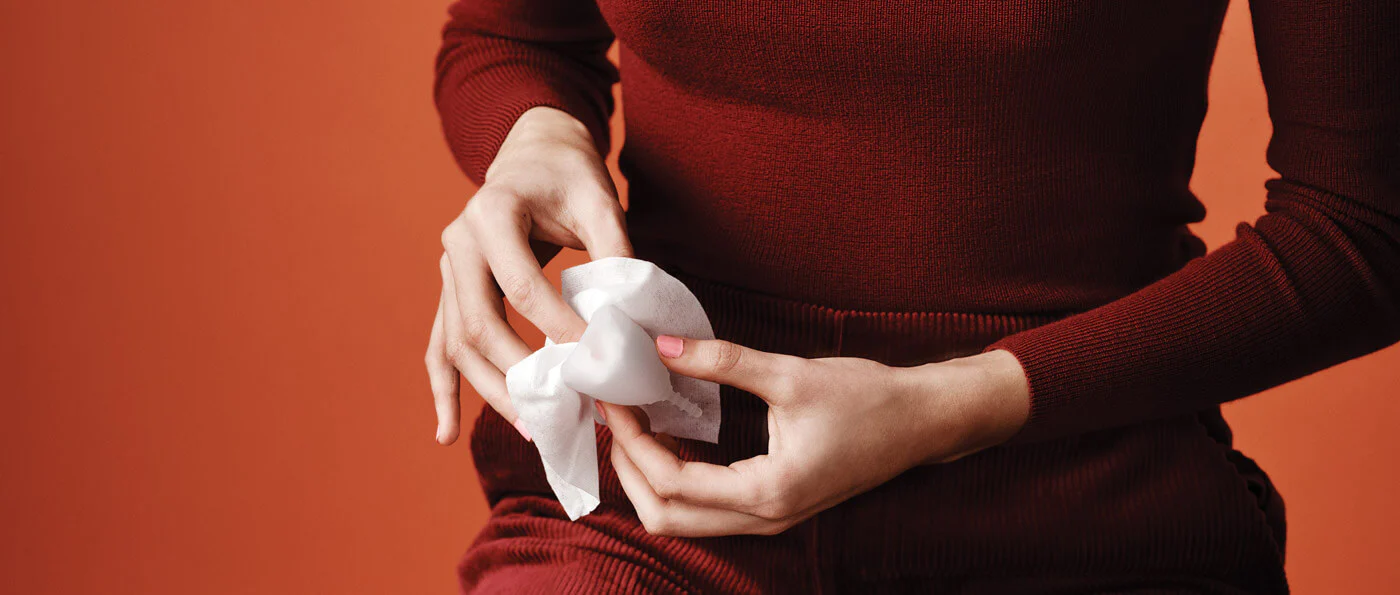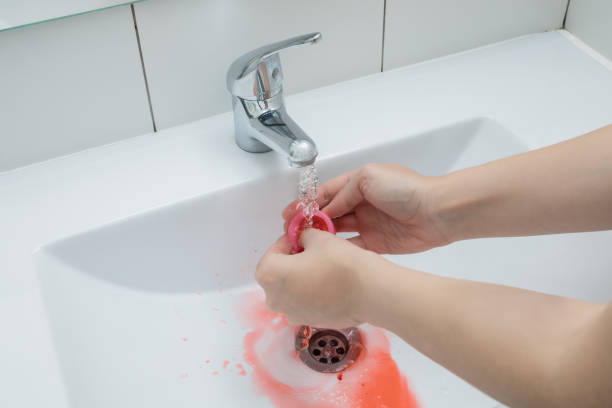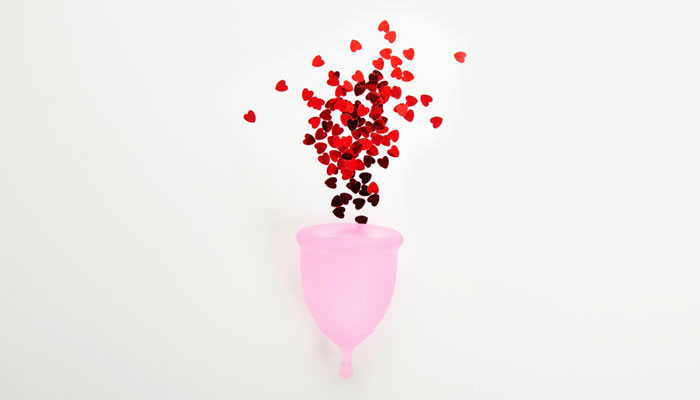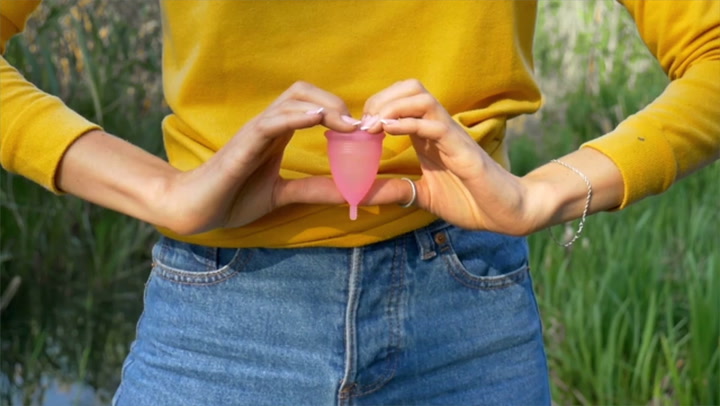Cleaning a menstrual cup is an essential part of maintaining good menstrual hygiene. With the right techniques and products, it’s super easy to keep your cup clean and sanitary. Whether you’re using popular brands like Juju Cups or Diva Cups, or any other menstrual cup brand, our cleaning recommendations are suitable for all. In this article, I’ll guide you through the simple guidelines on how to clean a menstrual cup effectively.

Contents
- 1 Initial Cleaning (Before First Use)
- 2 Preparing to Clean Your Menstrual Cup
- 3 Step-by-step guide to cleaning a menstrual cup
- 4 How to Remove Stains From Your Menstrual Cup
- 5 How Often Should You Clean and Sterilize Your Menstrual Cup?
- 6 Is it Bad if You Don’t Clean a Menstrual Cup?
- 7 Some Common Questions Answered
- 7.1 Is it better to steam or boil your menstrual cup?
- 7.2 How long should you boil your menstrual cup?
- 7.3 Is there a way to sterilize your menstrual cup without boiling it?
- 7.4 How can you clean your menstrual cup in a public bathroom?
- 7.5 How should you clean your menstrual cup after a yeast infection?
- 7.6 What products should you avoid when washing your menstrual cup?
- 7.7 How do you know when it’s time to replace your menstrual cup?
- 7.8 What should you do if your menstrual cup falls into the toilet?
- 7.9 Can you sterilize your menstrual cup in the microwave?
- 7.10 What kind of soap can you use to wash your menstrual cup?
- 8 How to Store Your Menstrual Cup Between Cycles
- 9 Conclusion
Initial Cleaning (Before First Use)
When it comes to cleaning your menstrual cup, proper hygiene practices are essential. Before using your cup for the first time, it’s important to give it a thorough initial cleaning. This will help ensure that it is safe and ready to use.
To begin, make sure to wash your hands thoroughly with soap and water. This will help prevent any potential bacteria from being transferred to the cup during the cleaning process. Once your hands are clean, you can proceed to clean the cup itself.
Start by rinsing the cup under warm running water. This will help remove any residue or debris that may be present on the surface. Be sure to use a mild cleanser specifically designed for menstrual cups. Avoid using harsh chemicals or cleaning agents, as they can potentially irritate sensitive areas.
After rinsing the cup, it is recommended to sanitize it by boiling it in water for a few minutes. This will help kill any remaining bacteria or germs. Make sure to use a pot that is designated solely for this purpose, as boiling the cup in a shared pot may contaminate it.
Once the cup has been sanitized, rinse it again under running water to remove any leftover cleanser or boiling water. Finally, dry the cup completely before storing it in a clean and dry place.
By following these steps, you can ensure that your menstrual cup is clean and ready for use. Remember to always wash your cup before and after each use, and to maintain proper hygiene practices throughout your menstrual cycle.
Preparing to Clean Your Menstrual Cup
Gather Necessary Supplies
Before you begin cleaning your menstrual cup, it’s important to have all the necessary supplies on hand. This will make the process more efficient and ensure that you have everything you need. Here are the supplies you’ll need:
- A clean sink with warm running water
- Mild cleanser designed for menstrual cups
- Pot for boiling the cup
- Clean towel or paper towel for drying
Having these supplies ready will help you maintain a clean and hygienic menstrual cup.
Wash Your Hands
The first step in cleaning your menstrual cup is to wash your hands thoroughly. This is important to prevent any bacteria or germs from transferring to the cup during the cleaning process. Follow these steps to properly wash your hands:
- Wet your hands with clean water.
- Apply a small amount of mild soap or cleanser.
- Rub your hands together, making sure to clean all surfaces, including between your fingers and under your nails.
- Rinse your hands thoroughly with warm water.
By washing your hands properly, you’ll ensure that you’re starting the cleaning process with clean hands, reducing the risk of contamination.
Remember, maintaining proper hygiene is crucial when handling menstrual cups. By following these steps, you’ll be well-prepared to clean your menstrual cup effectively and ensure optimal menstrual hygiene.
Step-by-step guide to cleaning a menstrual cup
Emptying the cup
The first step in cleaning a menstrual cup is to empty it. Carefully remove the cup from your body, making sure not to spill any contents. Empty the cup into the toilet or sink, whichever is more convenient for you. Remember to always wash your hands before and after handling the cup to maintain proper hygiene.
Rinse with cold water
After emptying the cup, rinse it thoroughly with cold water. This helps to remove any remaining menstrual fluid and prevent staining. Hold the cup under the tap and allow the cold water to flow through it, ensuring that all the surfaces are cleaned. Be sure to rinse both the inside and outside of the cup.
Clean with a mild soap
Once you have rinsed the cup with cold water, it’s time to clean it with a mild soap designed specifically for menstrual cups. Apply a small amount of the soap to the cup and use your fingers to gently rub the surfaces, ensuring that all areas are covered. Pay special attention to the rim and any ridges or grooves on the cup. Rinse the cup thoroughly with warm water to remove any soap residue.
Boiling the cup
To ensure proper sanitization, it is recommended to boil the cup after each menstrual cycle. Fill a pot with enough water to fully submerge the cup and bring it to a rolling boil. Carefully place the cup in the boiling water and let it boil for at least 5 minutes. This helps to kill any bacteria or germs that may be present on the cup. After boiling, remove the cup from the water using tongs or a spoon and allow it to cool before handling.
Air drying the cup
After cleaning and boiling, it’s important to thoroughly dry the cup before storing it. Use a clean towel or paper towel to gently pat the cup dry. Avoid using tissues or cloth that may leave lint or fibers on the cup. Ensure that the cup is completely dry before storing it in a breathable pouch or container. This helps to prevent the growth of bacteria or mold.
Remember to follow these steps before and after each use of your menstrual cup to maintain optimal hygiene. By properly cleaning and caring for your cup, you can ensure its longevity and enjoy a comfortable and healthy period experience.
How to Remove Stains From Your Menstrual Cup

Removing stains from your menstrual cup is an important step in maintaining its cleanliness and longevity. Over time, your cup may develop discoloration or stains due to the natural buildup of menstrual blood and other fluids. Here are some tips on how to effectively remove stains from your menstrual cup:
- Soaking in Hydrogen Peroxide: One effective method for removing stains from your menstrual cup is to soak it in hydrogen peroxide. Simply fill a bowl or container with hydrogen peroxide and place your cup inside, ensuring it is fully submerged. Let it soak for at least 30 minutes or overnight. After soaking, rinse the cup thoroughly with warm water.
- Baking Soda Paste: Another option is to create a paste using baking soda and water. Mix a small amount of baking soda with water to form a thick paste. Apply the paste to the stained areas of your menstrual cup and let it sit for a few minutes. Then, gently scrub the cup with a soft toothbrush or cloth. Rinse the cup thoroughly with warm water to remove any residue.
- Sunlight: Sunlight can also help to naturally fade stains on your menstrual cup. After cleaning your cup, place it in a sunny spot or near a window where it can be exposed to direct sunlight. Leave it there for a few hours or until the stains fade. Remember to rinse the cup thoroughly before using it again.
Remember, it’s important to always follow the manufacturer’s instructions for cleaning and care. While these methods are generally safe for most menstrual cup materials, it’s always a good idea to check with the manufacturer to ensure compatibility.
By regularly removing stains from your menstrual cup, you can keep it looking clean and fresh while maintaining proper hygiene.
How Often Should You Clean and Sterilize Your Menstrual Cup?
Cleaning and sterilizing your menstrual cup is essential to ensure its longevity and maintain proper hygiene. But how often should you perform these tasks? Here’s what you need to know:
- Cleaning: You should clean your menstrual cup before and after each use. This helps remove any residual blood or bacteria and keeps the cup fresh and odor-free. To clean your cup, simply rinse it with warm water and a mild, fragrance-free soap. Avoid using harsh chemicals, as they can damage the cup or cause irritation.
- Sterilizing: Sterilizing your menstrual cup is crucial to eliminate any harmful bacteria and keep it safe for use. It is recommended to sterilize your cup at the beginning and end of your menstrual cycle. This ensures that any potential bacteria or infections are killed off before you insert the cup again.
- Boiling: The most common method of sterilizing a menstrual cup is boiling it in water for 5-10 minutes. Make sure the cup is fully submerged in the water and avoid using metal utensils that could damage the cup.
- Sterilizing tablets: Alternatively, you can use sterilizing tablets or solutions specifically designed for menstrual cups. Follow the instructions provided by the manufacturer for the correct dosage and duration of sterilization.
- In-between cycles: During your menstrual cycle, simply cleaning your cup after each use is sufficient. However, if you feel the need for extra cleanliness, you can also sterilize it once in a while to ensure optimal hygiene.
Remember, always check the manufacturer’s guidelines for specific cleaning and sterilization instructions, as different cups may have different requirements. By following these cleaning and sterilization practices, you can maintain the cleanliness and effectiveness of your menstrual cup for longer periods of time.
Is it Bad if You Don’t Clean a Menstrual Cup?

What can happen if it isn’t cleaned properly
Proper cleaning and sterilization of a menstrual cup are essential for maintaining good hygiene and preventing potential health risks. Here’s what can happen if a menstrual cup is not cleaned properly:
- Bacterial growth: Menstrual blood provides a fertile environment for bacteria to thrive. If a menstrual cup is not cleaned thoroughly, bacteria can multiply and lead to infections such as bacterial vaginosis or urinary tract infections.
- Odor: Without regular cleaning, menstrual cups can develop an unpleasant odor. This is caused by the buildup of bacteria and menstrual fluid residue. Proper cleaning helps eliminate the odor and ensures a fresh and clean cup.
- Staining and discoloration: Menstrual cups that are not cleaned properly can become stained and discolored over time. This can be unsightly and may affect the cup’s overall appearance. Regular cleaning helps prevent staining and keeps the cup looking clean and clear.
- Decreased effectiveness: A dirty menstrual cup may not provide the same level of protection and comfort as a clean one. Menstrual cups that are not cleaned properly can become clogged with debris, affecting their ability to collect menstrual flow efficiently.
- Increased risk of infection: Unclean menstrual cups can introduce harmful bacteria into the vagina, increasing the risk of vaginal infections. Cleaning the cup thoroughly after each use helps prevent the transfer of bacteria and reduces the chances of developing an infection.
How often should you clean your menstrual cup?
To maintain proper hygiene, it is recommended to clean your menstrual cup before and after each use. This involves rinsing it with warm water and using a mild, fragrance-free soap. It’s important to avoid harsh chemicals or scented soaps, as they can cause irritation.
In addition to regular cleaning, it is recommended to sterilize the menstrual cup at the beginning and end of each menstrual cycle. This can be done by boiling the cup in water for a few minutes or using sterilizing tablets or solutions specifically designed for menstrual cups.
By following a regular cleaning routine and sterilizing the cup as needed, you can ensure that your menstrual cup remains clean, hygienic, and effective for longer periods of time. Remember to always follow the manufacturer’s instructions for cleaning and sterilization to maintain the cup’s integrity and longevity.
Some Common Questions Answered
Is it better to steam or boil your menstrual cup?
Both steaming and boiling are effective methods to sterilize your menstrual cup. Steaming involves using a special cup sterilizer that utilizes steam to kill bacteria, while boiling requires submerging the cup in boiling water. The choice between the two methods ultimately depends on personal preference and convenience.
How long should you boil your menstrual cup?
To properly sterilize your menstrual cup, it is recommended to boil it for at least 5-10 minutes. This duration ensures that any harmful bacteria or pathogens are effectively killed. However, always refer to the manufacturer’s instructions as boiling times may vary depending on the brand.
Is there a way to sterilize your menstrual cup without boiling it?
Yes, if boiling is not feasible or convenient for you, there are alternative methods to sterilize your menstrual cup. Some options include using specialized cup sterilizers that use UV light or hydrogen peroxide solutions. These methods effectively kill bacteria and ensure your cup is clean and safe to use.
How can you clean your menstrual cup in a public bathroom?
Cleaning your menstrual cup in a public bathroom can be challenging, but it’s not impossible. Here are a few tips:
- Use bottled water or a water bottle to rinse your cup over the toilet.
- Carry a small bottle of menstrual cup cleanser or mild soap in a travel-sized container.
- Consider using disposable menstrual cup wipes as a convenient and discreet option for cleaning on-the-go.
How should you clean your menstrual cup after a yeast infection?
After a yeast infection, it is important to thoroughly clean and disinfect your menstrual cup to prevent reinfection. Follow these steps:
- Wash your hands thoroughly before handling the cup.
- Remove the cup and rinse it with warm water.
- Soak the cup in a mild vinegar solution (1 part vinegar to 9 parts water) for 10-15 minutes.
- Rinse the cup with clean water and allow it to air dry or pat dry with a clean towel.
What products should you avoid when washing your menstrual cup?
When washing your menstrual cup, it is important to avoid using harsh chemicals, fragranced soaps, or douches. These can cause irritation, alter the pH balance, and potentially damage the cup. Stick to mild, fragrance-free, and non-toxic soaps specifically recommended for menstrual cup cleaning.
How do you know when it’s time to replace your menstrual cup?
Menstrual cups are generally durable and can last for several years with proper care. However, signs that indicate it’s time to replace your cup include:
- Visible signs of wear and tear, such as cracks or holes.
- A change in the cup’s shape or flexibility.
- Persistent odor or discoloration that cannot be removed with cleaning.
- If you have had a vaginal infection or any other health concern, it is recommended to replace the cup as a precautionary measure.
What should you do if your menstrual cup falls into the toilet?
Accidents happen, and if your menstrual cup falls into the toilet, don’t panic. Here’s what you should do:
- Wash your hands thoroughly.
- Retrieve the cup from the toilet using clean hands or a clean pair of tongs.
- Rinse the cup with warm water and mild soap to ensure it is clean and free from any contamination.
- Sterilize the cup before using it again, following the recommended sterilization method.
Can you sterilize your menstrual cup in the microwave?
No, it is not recommended to sterilize your menstrual cup in the microwave. The high heat generated in the microwave can potentially damage the cup or cause it to melt. Stick to boiling, steaming, or using specialized cup sterilizers for safe and effective sterilization.
What kind of soap can you use to wash your menstrual cup?
When washing your menstrual cup, it is best to use a mild, fragrance-free, and non-toxic soap. Avoid using soaps that contain harsh chemicals or fragrances as they can cause irritation or affect the cup’s integrity. Look for specially formulated menstrual cup cleansers or gentle, pH-balanced soaps that are recommended by the cup’s manufacturer.
How to Store Your Menstrual Cup Between Cycles

Properly storing your menstrual cup between cycles is essential for maintaining its cleanliness and longevity. Here are a few tips on how to store your cup effectively:
- Clean and dry: Before storing your menstrual cup, make sure it is thoroughly cleaned and completely dry. Residual moisture can promote the growth of bacteria or mold, leading to potential health risks.
- Choose the right container: It’s important to store your menstrual cup in a breathable container to prevent the growth of bacteria. Avoid using airtight containers or plastic bags, as they can trap moisture and promote bacterial growth. Instead, consider using a cotton bag or a ventilated container specifically designed for menstrual cup storage.
- Keep it in a cool, dry place: Store your menstrual cup in a cool, dry place away from direct sunlight and moisture. Exposing your cup to heat or humidity can affect its shape, flexibility, and overall quality. Avoid storing it in the bathroom, where it may be exposed to moisture and bacteria.
- Avoid contact with harsh substances: Keep your menstrual cup away from harsh chemicals, fragranced products, and cleaning agents that may damage the cup or cause irritation. These substances can degrade the silicone material and compromise the cup’s effectiveness.
- Regularly check for wear and tear: While storing your menstrual cup, take the opportunity to inspect it for any signs of wear and tear. Look for changes in shape, flexibility, or any damage that may affect its performance. If you notice any issues, it may be time to replace your cup.
By following these simple steps, you can ensure that your menstrual cup stays clean, fresh, and ready for use during your next menstrual cycle. Remember, proper storage is just as important as proper cleaning and sterilization in maintaining the hygiene and effectiveness of your cup.
Conclusion
Maintaining proper hygiene and cleanliness when it comes to your menstrual cup is essential for your overall health and well-being. By following the cleaning and sterilization tips mentioned in this article, you can ensure that your cup remains free from any potential health risks. Additionally, storing your cup correctly is equally important to maintain its cleanliness and longevity.
Remember to clean and dry your cup thoroughly before storing it. Opt for a breathable container, and keep it in a cool and dry place, away from direct sunlight and moisture. Avoid exposing your cup to harsh substances, as they can damage the material. Lastly, make it a habit to regularly check your cup for any signs of wear and tear.
By consistently following these steps, you can keep your menstrual cup clean, fresh, and ready for use during your next menstrual cycle. Taking the time to properly care for your cup will ensure that it remains a safe and reliable option for managing your period.
I am a medical student with experience and interest in Women’s health and well-being.